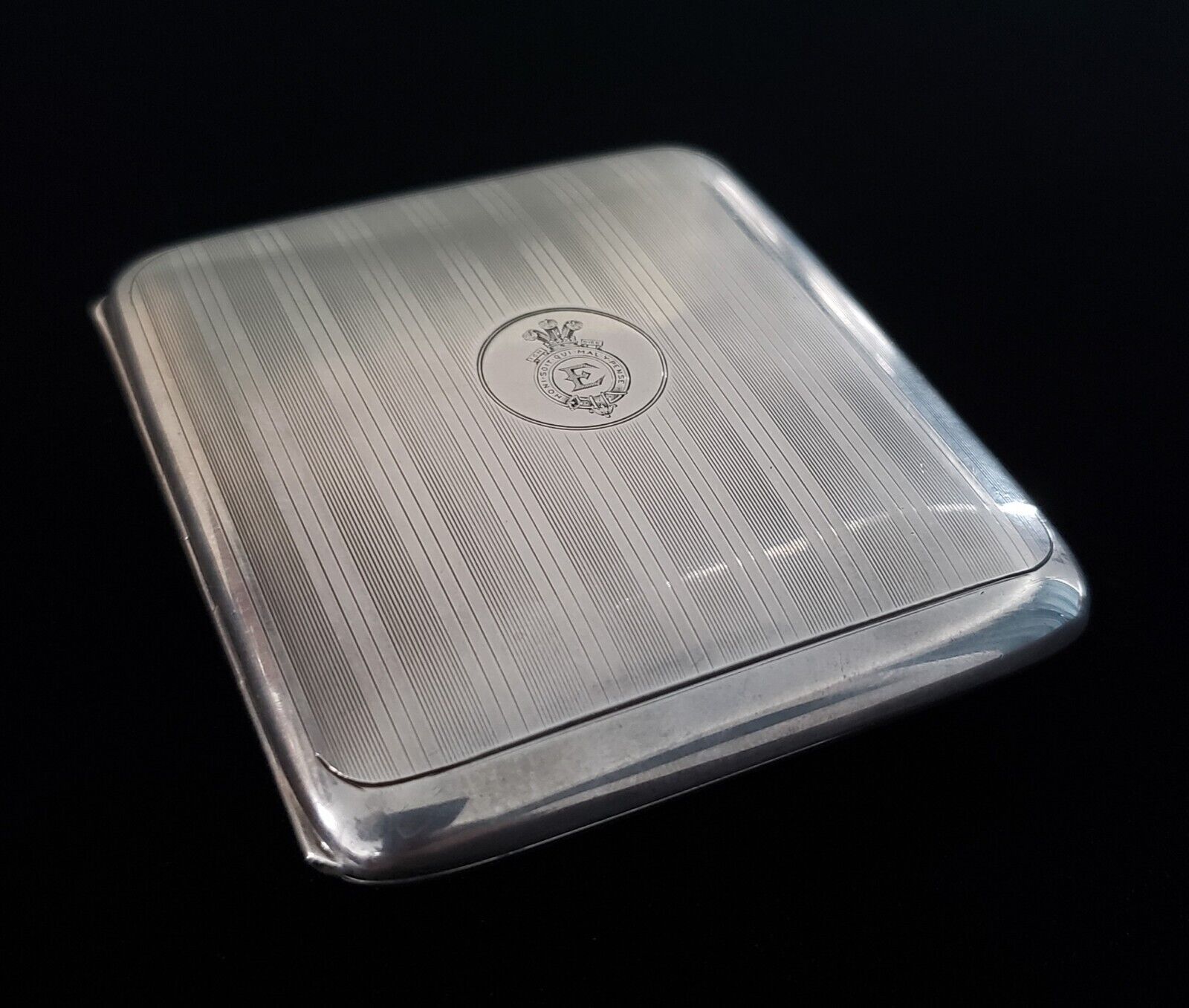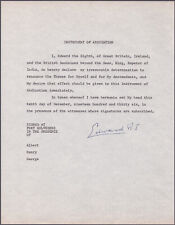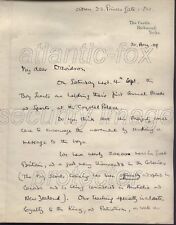King Edward VIII Duke Windsor Royal Silver Cigarette Case Royalty Wallis Simpson

When you click on links to various merchants on this site and make a purchase, this can result in this site earning a commission. Affiliate programs and affiliations include, but are not limited to, the eBay Partner Network.
King Edward VIII Duke Windsor Royal Silver Cigarette Case Royalty Wallis Simpson:
$5196.79
LOT-ME108. For your consideration is an exceedingly rare and historically important c.1929 original antique sterling silver royal presentation cigarette case, personally owned and used by HM King Edward VIII as HRH Edward, Prince of Wales. This royalty presentation case is not personalized or inscribed, which indicates that it was never presented as a gift and likely used by Edward VIII during his earlier years as a Royal Prince. Masterfully hand-engraved royal cypher / coat of arms for Edward VIII. Royal presentation case was manufactured by Sebastian Henry Garrard, royal jeweler to the Royal family. The case was made by Sebastian Garrard himself at their Albermarle Street workshop.Fully hallmarked SG for Sebastian Garrard, including additional hallmarks. Original bands still intact. Royal presentation case is original. Condition is original. King Edward VIII silver Royal presentation case measures approximately 3.25" x 3.0". Weight is approximately 136 grams.Royal blue Garrard presentation case measures 4.25" x 4.25". Guaranteed authentic. One of a kind. Museum quality.
Edward VIII (Edward Albert Christian George Andrew Patrick David; 23 June 1894 – 28 May 1972) was King of the United Kingdom and the Dominions of the British Empire and Emperor of India from 20 January 1936 until his abdication in December of the same year.
Edward was born during the reign of his great-grandmother Queen Victoria as the eldest child of the Duke and Duchess of York, later King George V and Queen Mary. He was created Prince of Wales on his 16th birthday, seven weeks after his father succeeded as king. As a young man, Edward served in the British Army during the First World War and undertook several overseas tours on behalf of his father. While Prince of Wales, he engaged in a series of sexual affairs that worried both his father and then-British prime minister Stanley Baldwin.
Upon his father's death in 1936, Edward became the second monarch of the House of Windsor. The new king showed impatience with court protocol, and caused concern among politicians by his apparent disregard for established constitutional conventions. Only months into his reign, a constitutional crisis was caused by his proposal to marry Wallis Simpson, an American who had divorced her first husband and was seeking a divorce from her second. The prime ministers of the United Kingdom and the Dominions opposed the marriage, arguing a divorced woman with two living ex-husbands was politically and socially unacceptable as a prospective queen consort. Additionally, such a marriage would have conflicted with Edward's status as titular head of the Church of England, which, at the time, disapproved of remarriage after divorce if a former spouse was still alive. Edward knew the Baldwin government would resign if the marriage went ahead, which could have forced a general election and would have ruined his status as a politically neutral constitutional monarch. When it became apparent he could not marry Simpson and remain on the throne, he abdicated. He was succeeded by his younger brother, George VI. With a reign of 326 days, Edward was one of the shortest-reigning British monarchs to date.
After his abdication, Edward was created Duke of Windsor. He married Simpson in France on 3 June 1937, after her second divorce became final. Later that year, the couple toured Nazi Germany, which fed rumours that he was a Nazi sympathiser. During the Second World War, Edward was at first stationed with the British Military Mission to France but after the fall of France was appointed Governor of the Bahamas. After the war, Edward spent the rest of his life in France. He and Wallis remained married until his death in 1972; they had no children.
Edward was officially invested as Prince of Wales in a special ceremony at Caernarfon Castle on 13 July 1911. The investiture took place in Wales, at the instigation of the Welsh politician David Lloyd George, Constable of the Castle and Chancellor of the Exchequer in the Liberal government. Lloyd George invented a rather fanciful ceremony in the style of a Welsh pageant, and coached Edward to speak a few words in Welsh.
When the First World War broke out in 1914, Edward had reached the minimum age for active service and was keen to participate. He had joined the Grenadier Guards in June 1914, and although Edward was willing to serve on the front lines, Secretary of State for War Lord Kitchener refused to allow it, citing the immense harm that would occur if the heir apparent to the throne were captured by the enemy. Despite this, Edward witnessed trench warfare first-hand and visited the front line as often as he could, for which he was awarded the Military Cross in 1916. His role in the war, although limited, made him popular among veterans of the conflict. He undertook his first military flight in 1918, and later gained a pilot's licence.
Edward's youngest brother, Prince John, died at the age of 13 on 18 January 1919 after a severe epileptic seizure. Edward, who was 11 years older than John and had hardly known him, saw his death as "little more than a regrettable nuisance". He wrote to his mistress of the time that "[he had] told [her] all about that little brother, and how he was an epileptic. [John]'s been practically shut up for the last two years anyhow, so no one has ever seen him except the family, and then only once or twice a year. This poor boy had become more of an animal than anything else." He also wrote an insensitive letter to his mother which has since been lost. She did not reply, but he felt compelled to write her an apology, in which he stated: "I feel such a cold hearted and unsympathetic swine for writing all that I did ... No one can realize more than you how little poor Johnnie meant to me who hardly knew him ... I feel so much for you, darling Mama, who was his mother."
Throughout the 1920s, Edward, as the Prince of Wales, represented his father at home and abroad on many occasions. His rank, travels, good looks, and unmarried status gained him much public attention. At the height of his popularity, he was the most photographed celebrity of his time and he set men's fashion. During his 1924 visit to the United States, Men's Wear magazine observed, "The average young man in America is more interested in the clothes of the Prince of Wales than in any other individual on earth."
Edward visited poverty-stricken areas of Britain, and undertook 16 tours to various parts of the Empire between 1919 and 1935. On a tour of Canada in 1919, he acquired the Bedingfield ranch, near Pekisko, Alberta. He escaped unharmed when the train he was riding in during a tour of Australia was derailed outside Perth in 1920.
His November 1921 visit to India came during the non-cooperation movement protests for Indian self-rule, and was marked by riots in Bombay. In 1929 Sir Alexander Leith, a leading Conservative in the north of England, persuaded him to make a three-day visit to the County Durham and Northumberland coalfields, where there was much unemployment. From January to April 1931, the Prince of Wales and his brother Prince George travelled 18,000 miles (29,000 km) on a tour of South America, steaming out on the ocean liner Oropesa, and returning via Paris and an Imperial Airways flight from Paris–Le Bourget Airport that landed specially in Windsor Great Park.
Though widely travelled, Edward shared a widely held racial prejudice against foreigners and many of the Empire's subjects, believing that whites were inherently superior. In 1920, on his visit to Australia, he wrote of Indigenous Australians: "they are the most revolting form of living creatures I've ever seen!! They are the lowest known form of human beings & are the nearest thing to monkeys."
In 1919, Edward agreed to be president of the organizing committee for the proposed British Empire Exhibition at Wembley Park, Middlesex. He wished the Exhibition to include "a great national sports ground", and so played a part in the creation of Wembley Stadium.
King Edward VIII Duke Windsor Royal Silver Cigarette Case Royalty Wallis Simpson:
$5196.79

Related Items:
King Edward VIII Duke Windsor Royal Silver Cigarette Case Royalty Wallis Simpson
$6495.99
KING EDWARD VIII - TYPESCRIPT SIGNED 12/10/1936
$5250.00
1909 Baden Powell original letter to King Edward VII. A UNIQUE SCOUTING RARITY
$4984.60







